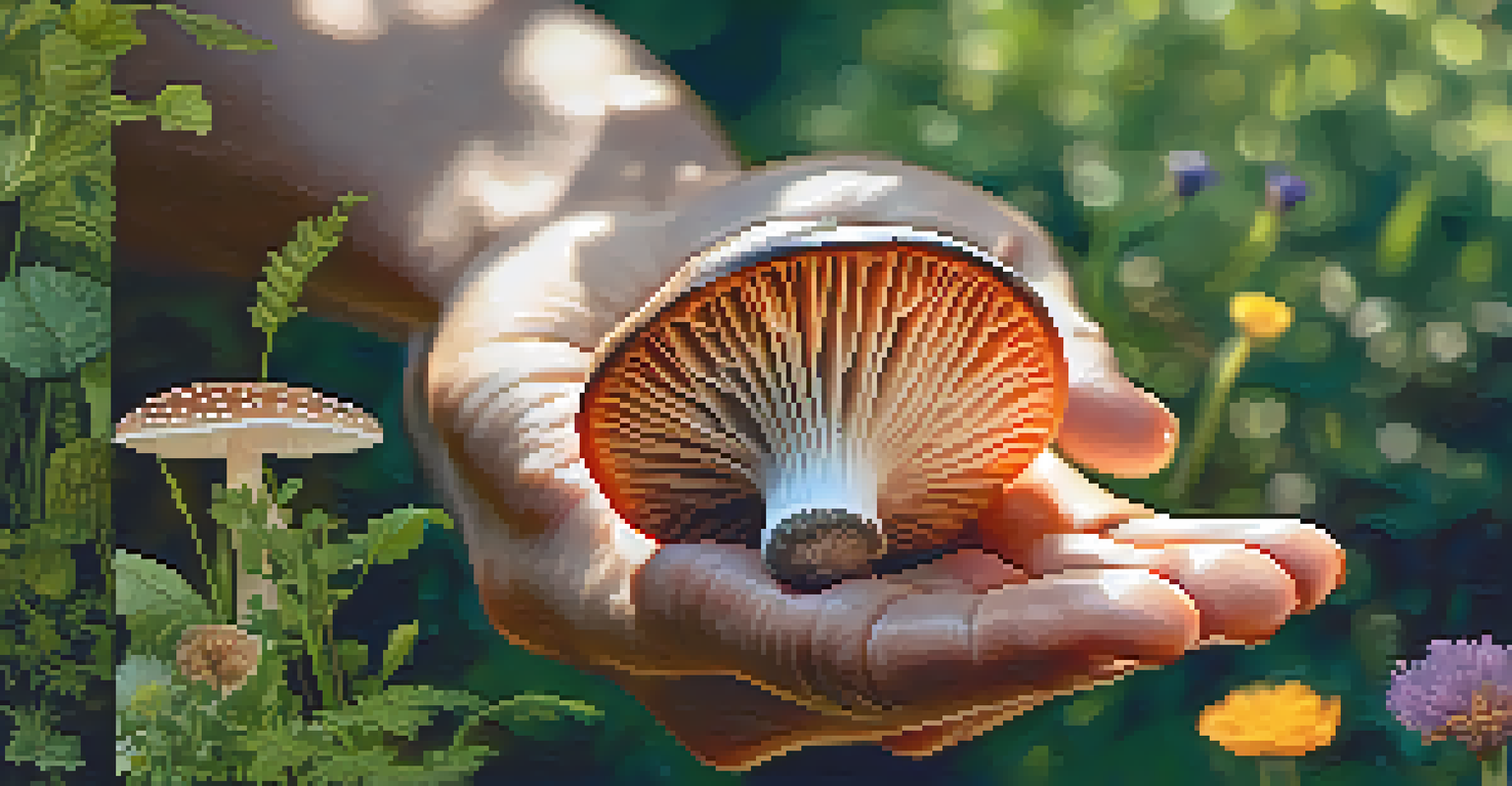The Role of Entheogens in Mental Health Research Advances

Understanding Entheogens and Their Historical Context
Entheogens, often referred to as psychedelics, are substances that have been used for centuries in various cultures for spiritual and therapeutic purposes. These compounds, such as psilocybin found in magic mushrooms and ayahuasca, have a rich history in indigenous rituals and healing practices. Their ability to facilitate profound experiences has piqued the interest of modern science, especially in the realm of mental health.
Psychedelics may offer profound insights and healing for individuals struggling with mental health issues, providing perspectives that traditional therapies sometimes cannot reach.
In recent years, there's been a resurgence of interest in these substances, particularly as traditional mental health treatments have shown mixed results for some individuals. Researchers are increasingly looking at how these natural compounds can play a role in addressing conditions like depression, anxiety, and PTSD. This renewed focus is not just about the substances themselves, but also about understanding the context in which they were traditionally used.
By embracing the historical and cultural significance of entheogens, mental health researchers hope to develop more holistic treatment approaches. This perspective encourages a deeper exploration of how these substances can foster healing, while also emphasizing the importance of safe and guided use.
The Science Behind Entheogens and Mental Health
Recent studies have shown that entheogens can lead to significant changes in brain chemistry, particularly by affecting neurotransmitter systems like serotonin. This has raised questions about their potential to alleviate symptoms associated with various mental health disorders. For instance, research on psilocybin has indicated that it can promote neuroplasticity, which is the brain's ability to reorganize and form new connections – a crucial factor in recovery from mental illnesses.

Moreover, entheogens often induce altered states of consciousness that can enable individuals to confront deep-seated emotions or traumas. This therapeutic aspect is what many researchers are excited about, as it may open doors to healing experiences that traditional therapies sometimes struggle to reach. The idea is that, through guided sessions with entheogens, patients can gain new perspectives on their challenges.
Entheogens' Historical Significance
Entheogens have been used for centuries in various cultures for spiritual and therapeutic purposes, highlighting their rich historical context.
However, it's important to note that this research is still in its early stages, and ongoing studies are needed to fully understand the risks and benefits. As scientists continue to explore these substances, they aim to establish rigorous protocols that ensure safety and efficacy in therapeutic settings.
Current Research Trends in Entheogen Studies
Currently, several institutions are at the forefront of entheogen research, focusing on their applications in treating mental health disorders. For example, studies at Johns Hopkins University have been groundbreaking in investigating the effects of psilocybin on anxiety and depression in terminally ill patients. The results have been promising, often resulting in profound improvements in patients' overall well-being and outlook.
The therapeutic potential of entheogens lies not just in the substances themselves, but in the context and care with which they are administered.
Additionally, the Multidisciplinary Association for Psychedelic Studies (MAPS) is leading research on MDMA-assisted psychotherapy for PTSD. This approach combines the therapeutic potential of MDMA with conventional talk therapy and has shown significant efficacy in clinical trials. These studies highlight a growing acceptance of entheogens in mainstream psychology as viable treatment options.
As the body of research expands, there is a push for more extensive clinical trials and a broader understanding of how these substances can be integrated into mental health care. This shift is paving the way for potentially revolutionary changes in treatment paradigms, moving away from one-size-fits-all approaches.
Challenges and Controversies Surrounding Entheogen Use
Despite the promising research, the use of entheogens is not without its controversies. Legal restrictions and societal stigma surrounding psychedelics can hinder research efforts and limit access for patients who might benefit from these treatments. Many entheogens remain classified as Schedule I substances in numerous countries, complicating their use in clinical settings.
Moreover, there are concerns about the potential for misuse and the psychological risks associated with unsupervised use of psychedelics. The experience can be overwhelming, and without proper guidance, individuals may not achieve the therapeutic benefits. Therefore, establishing a responsible framework for their use in therapy is crucial.
Research Validates Therapeutic Use
Studies indicate that entheogens can promote neuroplasticity and facilitate healing experiences, offering new avenues for mental health treatment.
To address these challenges, researchers and advocates are calling for policy reforms that recognize the therapeutic potential of entheogens while ensuring safety measures are in place. This includes advocating for more funding, education, and training for healthcare professionals in the field of psychedelic-assisted therapy.
The Role of Set and Setting in Entheogen Therapy
One of the key concepts in psychedelic therapy is 'set and setting,' which refers to the mindset of the individual and the physical environment in which the experience takes place. Research has shown that these factors significantly influence the therapeutic outcomes of entheogen sessions. A supportive and safe environment can enhance the healing experience, leading to more positive results.
Therapists often emphasize the importance of preparation and integration sessions, where patients are guided through their experiences before and after taking entheogens. This process helps individuals understand and process their feelings, making the experience more meaningful and beneficial. The goal is to create a nurturing environment that allows for exploration and growth.
By focusing on set and setting, mental health practitioners can optimize the therapeutic potential of entheogens, ensuring that patients are not only safe but also supported throughout their journey. This approach underscores the importance of a holistic view in mental health treatments.
Personal Stories: Healing Through Entheogens
Personal accounts from individuals who have undergone entheogen-assisted therapy often highlight transformative experiences that traditional treatments have failed to achieve. Many report profound insights, emotional release, and a renewed sense of purpose after their sessions. These narratives serve to humanize the research, illustrating the potential healing power of these substances.
For example, a veteran suffering from PTSD shared how a single MDMA-assisted therapy session allowed him to confront and process his traumatic memories for the first time. He described the experience as liberating, enabling him to reconnect with his emotions and relationships. Such stories resonate with many, emphasizing the need for more research and acceptance of these therapies.
Challenges in Psychedelic Therapy
Legal restrictions and societal stigma present significant hurdles for the research and clinical application of entheogens in mental health care.
These personal journeys not only provide anecdotal evidence of the benefits of entheogen use but also highlight the importance of shared experiences in the healing process. As more individuals come forward with their stories, they contribute to a growing movement advocating for the integration of entheogens into mental health care.
Looking Ahead: The Future of Entheogens in Mental Health Care
As research in this field continues to evolve, the future of entheogens in mental health care looks promising. With increasing interest from both the scientific community and the public, there's a growing push for more comprehensive studies and eventual policy changes that could facilitate broader access to these treatments. The hope is that entheogens will become a standard part of mental health care alongside traditional therapies.
Moreover, as the stigma surrounding psychedelics continues to diminish, we may see a shift in public perception and acceptance. Education and awareness campaigns can help demystify these substances, allowing individuals to understand their potential benefits and risks. This shift is essential for fostering a more informed dialogue about mental health treatments.

Ultimately, the goal is to create a landscape where entheogens are recognized as valuable tools in the mental health toolbox. By combining traditional therapeutic approaches with psychedelic experiences, we may pave the way for more effective and compassionate mental health care solutions.